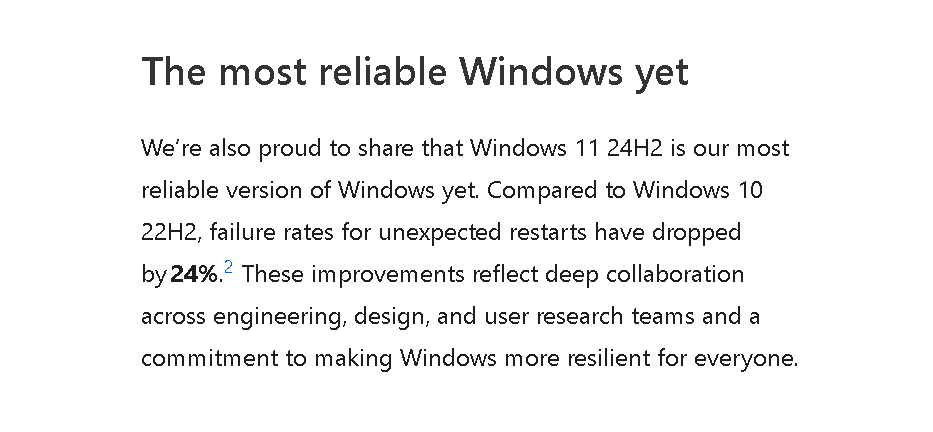Here’s an interesting bit of Windows administrivia. On July 22, a spellbinding Windows IT Pro Blog post appeared. It comes from Monika Sandhu, the Senior Program Manager who runs the company’s Windows Resiliency Initiative. Unsurprisingly, it’s entitled Resilience in action for Windows devices. There’s lots of good stuff in this piece, but I want to focus on her claim: 24H2 most reliable Windows yet. What does this means, and why does she say it?
Why Is 24H2 Most Reliable Windows Yet?
You can see that paragraph from her blog post, reproduced as the lead-in graphic above. This assertion stems from MS telemetry that reports on unexpected restarts and related failure rates. Apparently, they’re down by nearly a quarter (24%) as compared to Windows 10 22H2.
As somebody who’s run a modest Windows 10 fleet (up to 12-15 desktops and laptops), and who runs a similar-sized Windows 11 agglomeration right now, I can confirm her observation based on personal, if anecdotal experience. I don’t keep telemetry data around, but I do remember failure rates, restart problems, and so forth, across both Oses. For Windows 10, my experience goes back to October 14, when the first Technical Preview appeared. For 11, it goes back to June 2021. Over the interim, I’ve done dozens to hundreds of clean installs of both Oses, and hundreds of upgrades as well.
What Makes Windows 11 More Resilient?
I’ve seen the introduction of the reinstall now feature, which rebuilds whatever version of Windows 11 is running, including all current CUs, servicing stacks, and so forth. I’ve seen a demo of the Quick Machine Recovery facility which rebuilds the pre-OS-launch Windows startup/boot facilities. I believe this will work as MS describes it in actual deployment, too. And now, MS is talking about reworking the Startup Repair facility in WinRE (no doubt to match what QRM can already do).
So heck, yeah, I’m buying into this particular vision. In fact, I can’t wait to see QRM go into full production. I’m hoping it can save some butts the next time a Crowdstrike-like incident rears its ugly head. My thanks to Ms. Sandhu for sharing this info, and for injecting some hope that Windows-World could soon be a more resilient, less failure prone sphere to occupy. Let’s see what happens!
